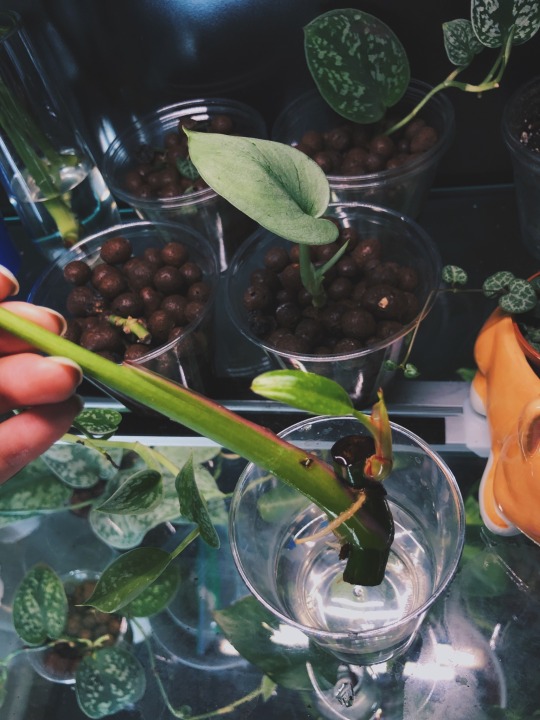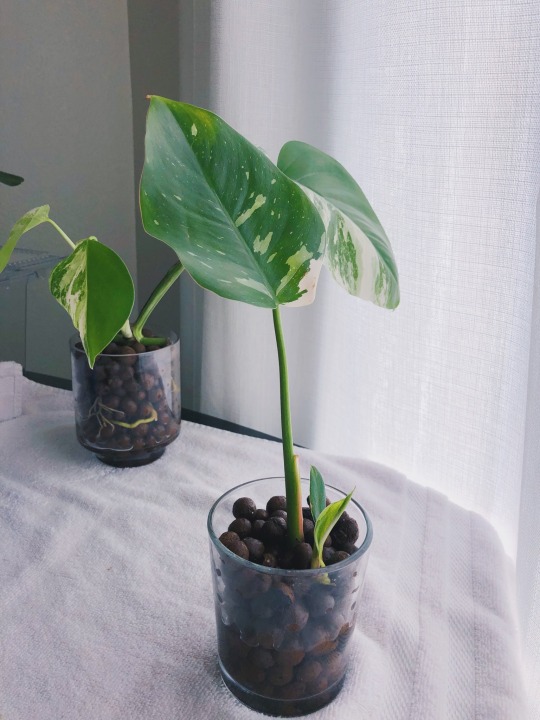Text






The Philodendron Tricolor White Princess
This right here is probably one of my favorites in my collection, even though it may not be as rare as my other ones. I remember purchasing this as a one-leaf cutting for a whopping $70. This was peak pandemic when everything jumped in price because people had nothing better to do. At this time I thought the price was atrocious for a leaf that was nearly all green and no pink at all, but now I can see why it was priced as such.
The tricolor white princess is one of my favorite variations of this plant. As you can see, the plant’s stem is predominately green with some pink, but it mostly expressed green and white variegated leaves. Occasionally, depending on the plants genetics, you might just get lucky and see some pink. However, variegated leaves sometimes aren’t all that great. They may be beautiful but because they aren’t green, they can’t photosynthesize and may reduce the plant’s growth rate. All white leaves are just a beautiful slow death.
I’ve taken progress photos of the plant’s growth over the span of a few months. To my surprise, this plant took off really quickly. I started with rooting the stem in some water and ultimately transferred it into leca. Please look at my previous post about using leca should you have any questions! When I first transferred it to leca, I used just plain water instead of nutrient solution until the roots grew more.
The first leaf it grew was just so tiny and plain green to my disappointment. However, it’s actually quite normal for a cutting to produce a small leaf as it’s first growth point because it needs to test if its environment can support it. To my surprise, the plant’s following leaf was a halfmoon! Halfmoons look like what it sounds like – half of the leaf is white. Afterwards, it spat out a nearly all white leaf. I was feeling quite stressed out and at the time I’m posting this right now, the leaf has already browned and fell off :(. However, I finally got a pink leaf! At this point I’m not exactly sure about the external factors that can encourage the plant to produce more pink. I’ve increased the lighting duration and humidity, but that’s still the only pink leaf I have. Check back in for more in the next few posts!
#house plants#home#leca#nature#plants#white princess#philodendron#monstera#follow#indoor plants#plant love#variegated
7 notes
·
View notes
Text


The Anthurium family: Timplowmanii and Warocqueanum
I have to admit that I’m not the best when it comes to anthuriums, and that’s ok! Many people experience difficulties with anthuriums due to their high humidity, proper drainage, airflow, and other requirements. I look at it weird and it’ll just start wilting away or something. In fact, the Warocqueanum’s nickname is actually the “Queen Anthurium” because of how fussy it is. It’s the most dramatic plant I have ever owned.
The “Queen”, pictured on the right, wasn’t my first Anthurium. I originally had a hybrid of the Queen mixed with a Waterburyanum, so I was somewhat familiar with how high maintenance the plant is. I struggled a lot with that plant and ultimately sold it to a friend. Luckily it’s doing much better now in his care! This plant originates from South America, so I had to obtain this one through a local importer here in San Diego by the name of Ecquagenera California. For full transparency, this plant was purchased for $50 from their California greenhouse. There is a discrepancy between their website and greenhouse prices because they already acclimate it for you versus if you purchased it online yourself and had it ship directly from South America.
While mine is a tiny baby right now at 3 inches, a Queen’s single leaf has the potential to get up to 6 feet. Can you imagine seeing a LEAF the size of a human being!? It would be a dream if mine could grow that large, but it’s not that simple unfortunately. It’s painfully a slow grower, and it doesn’t make it any easier that I live in a coastal desert climate. I currently keep my Ikea greenhouse cabinet at around 70 degrees fahrenheit and 70% humidity. Ideally this plant would love higher temperatures and higher humidity. Although the Timplowmanii is technically in the same family, it’s much more forgiving than the Queen. I purchased this one on a whim for just $15 because it was 50% off from the same importer at a plant show over at the San Diego Botanic Garden. With lower humidity requirements around 40-50%, this plant is currently thriving in my cabinet. The only complaint it’s given me so far is that it doesn’t like to have it’s substrate dried out. It’s tiny, has a funny ribbed texture, and has a spade-like shape. What plant should I post next?
6 notes
·
View notes
Text

Growing basil in leca! Feat. My dog!
Leca is a great sustainable alternative to using soil. You can continue to reuse it by boiling it in water to clean it from potential plant diseases. Made out of clay balls, leca itself doesn't actually contain any nutrients. However, you can easily substitute it with any nutrient solution. I personally use Foliage Pro with a one capful per gallon ratio.
In this picture, I started growing basil seeds in Leca to see how versatile it can be. I filled the container up with about an inch of the nutrient water and simply sprinkled some seeds on top. The leca wicks up the water and ensures that the seeds receive the moisture it needs. Depending on the type of plant, you may want to leave the water reservoir to dry out before refilling the container back up with nutrient water. However, basil is a plant that can grow in a full hydroponic environment, meaning that the plant can be perfectly happy in water and does not need any soil.
Basil is one of my favorite herbs, and I am happy for a semi hydroponic system I can easily use in my apartment. It’s so simple and easy to the point where I’m not even sure if I would consider it a system. Leca is an excellent choice for those who are city-dwellers or simply don’t have enough yard space to grow miscellaneous herbs. You can cut back the roots if necessary or just transfer it into a larger container when it outgrows the cup. It’s lower maintenance than using soil as you don’t have to continually fertilize it and make sure that your soil has the proper drainage. My favorite part about it is that it is also much more aesthetic to the eye.
Aside from convenience and aesthetics, there are many other benefits to using leca. The first major one is pests. Due to soil’s organic composition, it naturally attracts insects. Some of these pests are harmful to your plants. Leca is just clay so you won’t have to worry about soil mites, gnats, or other annoying pests. A second benefit is that it doesn’t smell at all. Personally, I can’t stand the smell of organic fertilizer (poop!) in my house. Lastly, you don’t have to worry about soil spilling and getting everywhere. Comment down below if you’re already using leca or considering it!
5 notes
·
View notes
Text
Hi everyone, welcome to my first blog post!
If I could only pick one plant to keep, then it would be this one. This is one of my many Monstera Variegata Albos and it was my wishlist plant for the longest time. I remember when I found it on Facebook Marketplace and a single leaf was a whopping $100. At the time this was a really good deal because of the plant craze during COVID. I couldn’t believe a leaf could cost that much and the worst part was that I went to meet up at night at some random gas station to buy it.
Part of the arum genus, the Albo exhibits the same growth patterns as the normal Monstera. In fact, both the variegated and non-variegated versions produce fruit! However, it differs from a regular Monstera plant because of how the leaf expresses white variegation. This type of variegation cannot be cloned or tissue cultured which makes the plant more valuable.

As you can see, I was attempting to root both the node and the single-leaf cutting in leca. This was my first attempt at rooting using leca, a soil-free alternative. At this point in time, The single-leaf cutting had already been rooting in water, so it thrived in leca. Unfortunately I can’t say the same for the node. The node was previously in moss before I transferred it into leca. However, I would recommend you to pick one method of rooting and sticking with it because the node ultimately rotted.
Pro tip! Keep the node dry and out of water!
Your node is more prone to rotting if it is constantly wet. Try to elevate it and only leave your plant’s roots in your rooting medium.

After the course of one month, my single-leaf cutting sprouted a small, but beautiful leaf. Similarly to its mother’s leaf, the new leaf also exhibits the same “half-moon” variegation. You can also see that it has very healthy white roots. These roots are different from if you were to plant the leaf into soil. White roots are a sign of healthy water roots. This means that the roots have adapted to being in water instead of soil. You should still occasionally check for black rotting roots by just rinsing the pot with some water and then flushing it out. Usually a little rot is okay unless the entire thing smells gross. I’ll make a post soon about how to use leca.
#home#house plants#nature#plants#albo#variegated#rare plants#vsco#blog#leca#monstera#philodendron#clay
6 notes
·
View notes